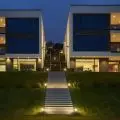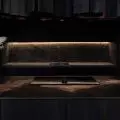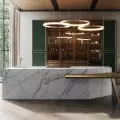text by Joanna Erbel from A&B issue 04|2022
The story of this text began with an event. In the autumn of 2021, I was invited to a workshop on Krakow's Wesola at the International Architecture Biennale, the main part of which was held at Krakow's ICE Congress Center. This building, designed by Ingarden & Ewý in collaboration with Japanese architect Arata Isozaki, is a business and cultural landmark of the city. Its edgy facade shimmers invitingly on the right bank of the Vistula River as you cross the bridge from the old city. It is one of the iconic buildings that are meant to delight us.
trap buildings
I was looking forward to visiting ICE, because until now I had only known the interior of this building from photographs. However, my admiration for the form passed very quickly. Shortly after I stepped inside, I realized that this is one place where beauty does not go hand in hand with functionality. And the ICE foyer itself, where the workshop was to be held, is an acoustic torture chamber. I lasted less than a quarter of an hour inside, after which I had to save myself by escaping outside. Overwhelmed by the sounds reverberating inside the fancifully designed block, I turned from a darting expert into an amoeba jittery from an excess of emotions. An architectural icon turned out to be a trap building for me.
ICE foyer during the International Architecture Biennale Krakow 2021
© Lubomir Nikolov
I am a high-functioning person on the autism spectrum, so I feel most stimuli more strongly, especially when I spend time in a larger group of people. I've been involved in urban spaces for years, and I'm usually able to recognize in advance the places where I will feel unwell. However, this is not always the case, for the experience of the body is a multi-sensory experience, and the pictures do not show issues such as acoustics, light levels or other factors that, in people with heightened sensitivity, can make us dream only of escape instead of having a pleasant and productive time. Autism spectrum disorder, like ADHD, dyslexia, dysgraphia, dyscalculia are various conditions related to brain development that affect the way we perceive and relate to others, which can cause problems in social interaction, communication, learning, and various forms of sensory hypersensitivity. The umbrella term for this multiplicity of ways in which the brain works is neurodiversity. In a world that forgets our needs, this otherness makes the city an obstacle course.
Sometimes dangers hide in the most unexpected places. For those suffering from photogenic epilepsy, light stimuli that cause a pulsating effect on the walls are a threat. In Warsaw's ZODIAK Pavilion, such a spot is the toilet - its walls are lined with tiny black-and-white squares. A similar visual solution has also appeared at the Targówek Mieszkaniowy station, on the second line of the Warsaw subway. Such an effect is also produced by the foyer and elevators in the Varso building, where steel and copper elements create a pattern on which it is difficult to focus the eye. These types of solutions cause a headache, but can also lead to an epileptic attack, yet they usually appear in spaces that are considered well-designed and are also often, like ICE or ZODIAK, awarded by architectural juries. Details that may be barely noticeable to most people sometimes turn out to be crucial for neurodiverse people and effectively prevent us from fully participating in social life.
find the key to good design
Designing inclusive spaces is about avoiding silly mistakes that will make a person feel bad about his or her mobility limitations or hypersensitivity. At the same time, we live in a world where each and every one of us has slightly different limitations, so we look for simple rules that sensitize us to the needs of others. In such situations, it is best to look through the eyes of the weakest, because it is their sense of space that is the key to unpacking such a complex system as a city. This approach is based on the simple premise that if we map the experiences of those who are most vulnerable to various forms of discrimination, they will form a certain spectrum within which everyone else will also fit. This is the basis of the principles of universal design, a design philosophy based on the belief that both products and environments should be made to be used by all people, without the need for adaptation or special solutions.
CIC Warsaw, green section, proj.: Workplace - soft alcoves surrounded by greenery are places where you can relax while working or even take a nap; they are located in a little-used part of the coworking space, so they are ideal for people on the autism spectrum; soft upholstery is an additional soothing element
© Workplace
The first step is already behind us. Over the past years, we have learned to look at space through the lens of the needs of groups with limited mobility: people with disabilities, parents with children, the elderly. The best-known example of operationalizing this intergenerational perspective is the 8-80 methodology prepared by urban planner Gil Peñalosa, who convinces us that a city that is safe for eight- and eighty-year-olds will also be good for everyone else. The children's and old age keys are only concerned with two social groups, but if we look at the detailed guidelines, we see that they accommodate other issues as well: spaces for the elderly are the same ones needed by people of other ages, but who move in wheelchairs, with strollers, have problems with vision or orientation in space. Design for children, on the other hand, takes into account not only safety issues (i.e., limiting cars), but also the presence of a network of public spaces, preferably filled with greenery with which to interact (lie on the grass, walk through the trees, pick flowers) and which is appropriately diverse, so biodiverse. The same is true of neurodiversity, which is another key to designing friendly spaces.
CIC Warsaw, pro: Workplace - phone booths provide not only privacy for conversations, but also a respite from the noise of open spaces
© Workplace
The litmus test here may be neurologically atypical people, i.e., those whose brains function in a different way than is considered the norm. Neurotypical people are about 20-30 percent of the population. If we didn't receive a diagnosis as children, it's often only in adulthood that we find out we are different, often only when we look at our own children and see that they are more sensitive to their environment than their peers and contemporaries. At the same time, neurodiversity is not an opposition to neurotypicality, but a certain enhancement of traits. The world of neurotypical people can be compared to a state of extreme fatigue, in which our brains have difficulty processing information quickly. A space designed with care for the needs of neurotypical people will therefore also be more comfortable and soothing for everyone else - in much the same way that accessibility for wheelchair users increases the comfort of parents with children or travelers with suitcases.
hypersensitive senses test
Neurodiversity is a perspective that will enhance the quality of design. However, while in the case of physical accessibility of spaces a closed catalog of guidelines can be created and spaces and buildings can be audited, in the case of designing for neurodiversity there is no one-size-fits-all solution. This is not only because individuals' brains need different levels of stimulation, but also because this level of stimulation varies depending on the level of fatigue, the type of task being performed or overall psychophysical condition. Thus, concern for the needs of atypical individuals and other social groups is based on a multifaceted approach to space, addressing our senses of hearing, sight, smell and touch, as well as more ephemeral issues such as atmosphere or the level of clarity of the rules of the place. Neurological interactions with the environment tend to be cognitively challenging for atypical individuals and their brains constantly recalibrating information from the environment. We are often overstimulated, and ADHD individuals are under-stimulated and fatigued.
CIC Warsaw, design: Workplace - one of the meeting rooms: the level of light intensity can be selected here; those needing lots of light can turn on all the LEDs, for those wishing to maintain an intimate atmosphere there is a chandelier with warm light bulbs; the author of the text, as a person hypersensitive to artificial light, was most likely to use the lighting from the corridor, which gently flowed into the room; the choice of multiple levels of intensity makes it easier to adapt the space to the needs of atypical people
© Workplace
This multiplicity of needs may seem difficult to quantify and write down in the form of rules, but only seemingly so. All we need to do as individuals designing a space or a given event is to consider what would happen if any of our senses were overly sensitive. First of all, what would happen if our eyes saw light more strongly, like when we have our eyes spiked with atropine during an eye exam or suffer from eye inflammation. The main challenge then is excess light, especially artificial light. Here, too, space legibility becomes an important issue, especially important for dyslexic people. Second, what would happen if we could hear more strongly, and all the sounds around us would come at us intensely, as if it were a techno party at a neighbor's house, when we are tired after a day's work and trying to relax. Third, what would happen if we smelled odors like hounds? How neutral would the smells of cleaning products, food or those resulting from the presence of other people, such as strong perfume, be? Fourth, what if we had very sensitive skin. How would we react to furniture upholstery, for example.
CIC Warsaw - kitchens, pro: Workplace - the kitchen on the second floor is connected to the game room, dominated by intense shades of red, yellow, green and blue; this is where people with ADHD will feel comfortable at times when they need extra stimulation to work effectively.
© Workplace
For highly sensitive people, in addition to these four senses with which we perceive a space, the energy flowing between the people present in a room, the intention of the organizers of a particular meeting, or the level of involvement of individuals in an event is also important. It is also the energy of a place, which is poetically called its spirit. Overly strong intuition is a quality that, even more than beauty, eludes description, one aspect of our cognition that is sometimes particularly sensitive in neurologically atypical people. Having a slightly differently calibrated body and senses than most people, we acquire a lot of information non-verbally. We can be in a well-designed space, at a meeting in a pleasant atmosphere, and yet feel that something is off. Perceiving these energy dimensions, which are difficult to name, causes highly sensitive people to quickly deplete their energy deposits after going out into the outside world. It is also not always possible to avoid places marked by difficult events of the past; after all, our cities are full of such spaces. However, being aware of how strongly space affects us can make us learn to create places where each and every one of us feels our best.
CIC Warsaw - each room has a name (not a number); the name of the room corresponds thematically. The letters are large, written in fonts without unnecessary embellishments; this solution makes it very easy for dyslexic people to navigate the space - design: mode:lina
© mode:rope
What's more, when designing good spaces, we should not aim to standardize a given place or building, but think about creating a diverse space where we can move seamlessly between different levels of stimuli. For example, a well-designed building is one in which we can find both large open spaces for meetings in a larger group, and intimate corners for private conversations or that allow us to rest from an excess of stimuli. These spaces should co-occur in order to be able to choose. Being able to escape to a quiet place is a very important issue for people on the autism spectrum and highly sensitive people who, in order to be with other people, need a break from stimuli every now and then without leaving the building. This sequencing of different types of rooms will not only benefit atypical people, but also create an interesting, diverse space that is functional and visually appealing.
Joanna ERBEL
Illustrations from Cambridge Innovation Center Warsaw provided courtesy of
Workplace and mode:lina studios
Joanna Erbel - sociologist, urban activist, housing expert. Founder of the Blisko Foundation dedicated to supporting local activism and creating knowledge on housing innovation. She coordinated the preparation of the housing policy and the Housing 2030 program for the city of Warsaw. From 2017 to 2020, she was in charge of the topic of housing innovation at PFR Real Estate. She is a member of the expert group of the Rental Market Laboratory and CoopTech Hub, the first cooperative technology center in Poland. Author of the books "Beyond Ownership. Toward a successful housing policy" (2020) and "Leaning into the future. How to change the world for the better" (2022). She is an associate of the A/Type Foundation, which works for neurodiversity.














































